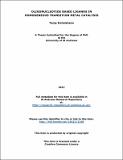Files in this item
Oligonucleotide based ligands in homogeneous transition metal catalysis
Item metadata
| dc.contributor.advisor | Dervan, Peter B. | |
| dc.contributor.author | Eichelsheim, Tanja | |
| dc.coverage.spatial | vi, 111 | en_US |
| dc.date.accessioned | 2012-10-05T08:31:56Z | |
| dc.date.available | 2012-10-05T08:31:56Z | |
| dc.date.issued | 2012-11-30 | |
| dc.identifier | uk.bl.ethos.558122 | |
| dc.identifier.uri | https://hdl.handle.net/10023/3168 | |
| dc.description.abstract | Catalysis plays an important part in our society. Numerous transition metal catalysts have been developed which can convert many different substrates in a wide range of reactions. Catalysis also plays an important role in nature and therefore special catalysts, enzymes, have evolved over time. Enzymes are tremendously efficient giving high yields and selectivities both regio and chemical but have a limited substrate and reaction scope. It was speculated that by combining the two, an ideal catalyst can be obtained. We planned to achieve this by introducing a transition metal, the catalytic centre, into the chiral environment of a double helical oligonucleotide. The transition metals were introduced by coordinating them to a ligand which was located in the chiral environment of a double helix. The ligand was either covalently bound (Chapter 2) or non-covalently bound (Chapter 3) to the oligonucleotide. For the covalent approach a phosphine ligand was chosen. A nucleoside was modified with an alkyne to which a phosphine moiety could be coupled via the copper catalysed 1,3-dipolar cycloaddition. The modified nucleoside was incorporated into an oligonucleotide before attempting to attach the phosphine moiety. The monomer was used as a ligand in allylic substitution and hydroformylation. In the non-covalent approach polyamide minor groove binders were functionalised with an amine linker. Phosphine moieties were connected via amide bond formation. Although the coupling worked effortlessly the phosphines oxidised during purification therefore dienes were also investigated. | en_US |
| dc.language.iso | en | en_US |
| dc.publisher | University of St Andrews | |
| dc.rights | Creative Commons Attribution-NonCommercial-NoDerivs 3.0 Unported | |
| dc.rights.uri | http://creativecommons.org/licenses/by-nc-nd/3.0/ | |
| dc.subject | DNA | en_US |
| dc.subject | Catalysis in aqueous media | en_US |
| dc.subject | Allylic substitution | en_US |
| dc.subject | Hydroformylation | en_US |
| dc.subject | Transition metals: palladium and iridium | en_US |
| dc.subject.lcc | QD505.E5 | |
| dc.subject.lcsh | Catalysis | en_US |
| dc.subject.lcsh | Transition metal catalysts | en_US |
| dc.subject.lcsh | Enzymes | en_US |
| dc.subject.lcsh | Oligonucleotides | en_US |
| dc.subject.lcsh | DNA | en_US |
| dc.title | Oligonucleotide based ligands in homogeneous transition metal catalysis | en_US |
| dc.type | Thesis | en_US |
| dc.type.qualificationlevel | Doctoral | en_US |
| dc.type.qualificationname | PhD Doctor of Philosophy | en_US |
| dc.publisher.institution | The University of St Andrews | en_US |
| dc.publisher.department | California institute of Technology | en_US |
This item appears in the following Collection(s)
Except where otherwise noted within the work, this item's licence for re-use is described as Creative Commons Attribution-NonCommercial-NoDerivs 3.0 Unported
Items in the St Andrews Research Repository are protected by copyright, with all rights reserved, unless otherwise indicated.


